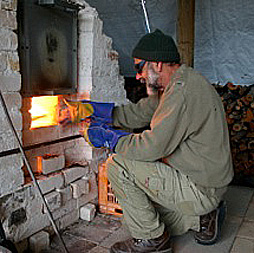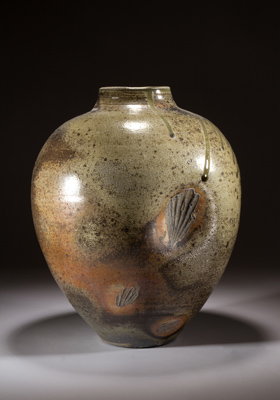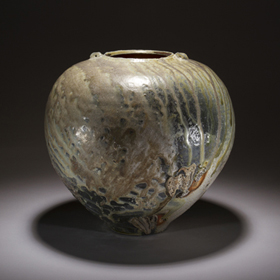 Stewart Scambler:
Stewart Scambler:
Belonging to where I am
Stewart Scambler by Geoff Vivian
Stewart Scambler likes to talk about the quality of a rock in the landscape.
“There’s a rightness about its presence there, a quality of stillness that exists and a quality of discovering something new and previously unseen when you lift that rock,” he says.
Every winter he returns to his three-hectare property near York to face the elements of fire and earth. If you visit him there you may find him slowly filling his massive self-built kiln with stoneware pots made from clay he mined nearby at Bolgart. His only fuel is wood from the native trees he and his wife Trish have grown on the block, their smoke and ash lending colour and texture to the glazes.
“I use that wood in particular because it’s of the place,” he says. “I am really interested in the stuff belonging to where I am.”
He says his sense of landscape and place began while exploring the bush with a group of boys. Migrating from Scotland at the age of seven, he lived with his family in what was then the semi-rural community of Kwinana. “I got used to that idea of walking round and looking at the bush with a pack of boys and talking to some Indigenous families down there,” he says. “I consider myself very lucky.”
 Later, as a young soldier, he says he felt that same stillness in the Australian desert which he has tried to reflect in his work ever since.
Later, as a young soldier, he says he felt that same stillness in the Australian desert which he has tried to reflect in his work ever since.
He began to study under Michiko Love and Heather McSwain at South Fremantle TAFE, before receiving an invitation to study in Japan in the early 1980s.
“After spending two weeks looking around I just decided I would rather round out my career in working and learning in Australia,” he says. “I didn’t want to be that influenced by what they did. I knew I could very easily become Japanese in my thinking and the way I worked.”
He says his work, and pottery itself, has gone in and out of vogue.
“In the 70s everything I made would sell,” he says. “From the public point of view I guess brown mugs and brown casseroles, they were flavour of the month. My feeling about what I was doing may not have been though. My interest in the land then was probably quite unfashionable.”
As a long-standing teacher at Fremantle Arts Centre, Stewart says he sees a resurgence in people taking up the craft.
“I felt like a dinosaur for a while,” he says. “I was nearly the only person teaching at the art centres, teaching ceramics, and over the last few years it’s grown.
 It’s become so difficult in the universities and the techs. They are starting to discard their ceramic courses, so people are moving and are starting to get taught by practitioners without conceptual theory and they are starting to enjoy it.”
It’s become so difficult in the universities and the techs. They are starting to discard their ceramic courses, so people are moving and are starting to get taught by practitioners without conceptual theory and they are starting to enjoy it.”
In summer he works at his Palmyra studio, bisque firing the pots he will refire at York, and throwing Maiolica* ware that Trish paints. He also produces a range of stoneware, fired in an electric kiln, with a colour scheme more reflective of the coastal limestone environment. They subscribe to Green Power to offset the kiln’s environmental impact.
Stewart says he expects to keep making pots until the day he dies.
“I’m going to take my own path along exploring the land and seeing how close I can get to that idea of the rock in the landscape, the bisque coats, the tissue you see when you first lift up the rock in the desert when no one else has looked,” he says.
Geoff Vivian, a former studio artist, is a freelance writer and photojournalist who has also spent more than a decade working in community development for local councils and as the manager of the Aboriginal radio station at Halls Creek.
To view more of Stewart's work and read about his practice and career, see his page in the Artsource Gallery.
* Maiolica - the refined, white-glazed pottery of the Italian Renaissance